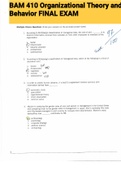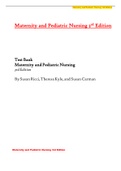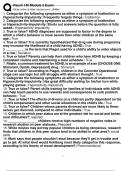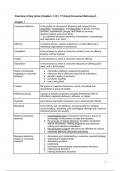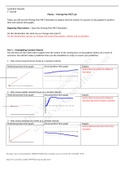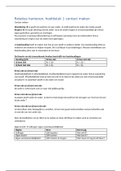Forensic Psychology
Lecture 1. Introduction
Edmund Kemper
• bad childhood: mother doesn’t show love and his relationship with his sisters is also not good
• runs away and goes to his father at 14 years old but got send away to his grandparents
• grandmother is like his own mother, after a fight he shoots his grandmother in the head
• afterwards he kills his grandfather because he felt sorry for him, he didn’t want him to live
without her but that is a strange answer because Ed was a smart guy
• he calls his mother and then calls the police
• he stays in a psychiatric prison for a couple of years, got released at 21 years old and goes
living with his mother again
• was a perfect prisoner, really calm
• buys a car and starts to pick up hitchhikers, especially young girls, after 150 pickups it starts to
go wrong, he starts experimenting because he felt sexually
• kills a girl for the first time and throws her in a river, afterwards this happens again with 4 girls
• he kills his mother in a cruel way; symbolic meaning: cuts of tongue because of verbal abuse
• in detention he was very cooperative with the police, he helped them to show what he did,
where, why, … he was one of the few serial killers who acted like that
• never killed again after his mother, had no meaning anymore because all the hatred was gone
• wanted to pay for his sins, he asked for the death penalty and tried to kill himself twice
1.1 Towards an understanding
Towards an understanding
• forensic psychology ≠ forensic science or law enforcement
• (forensic) psychologist studies human behaviour
• tries to apply psychological principles to assist legal system
“Forensic”
• “forensis” = of the forum
• “related to the law”
• psychology + law = forensic psychology
1.2 History
History
• Middle Ages and earlier: good and wrong related to religion, demons, witches, sinners …
o if you did something wrong, you were probably under possession of a demon
o however: individual liability (you are responsible for your actions)
• End of Middle Ages: first use of the word ‘insanity’
o the person might not be in full control of his deeds
• 19th century: criminal atavism = you can recognize criminals to specific physical anomalies
o criminals → physical anomalies (Lombroso)
1
,“In general, thieves are notable for their expressive faces and manual dexterity, small wandering eyes
that are often oblique in form, thick and close eyebrows, distorted or squashed noses, thin beards and
hair, and sloping foreheads. Like rapists, they often have jug ears. Rapists, however, nearly always have
sparkling eyes, delicate features, and swollen lips and eyelids. Most of them are frail; some are
hunchbacked.” (Lombroso, 1876)
History
• 19th century: development of theories around insanity and criminal behaviour
• 1879: first laboratory for experimental psychology (W. Wundt)
• 1908: book ‘on the witness stand’ from Münsterberg
o series of essays to describe research on eyewitness testimony, false confessions, and
uses of psychology in legal problems
• 20th century: psychologists were more and more called upon to apply their (rudimentary)
knowledge to the legal system as expert (e.g., testifying as expert witness)
o psychology = a tool in arriving at fair and just legal outcomes
• Jenkins v. United States (1962): court ruled that psychological testimony could be admitted to
determine criminal responsibility (i.e., insanity)
o forensic psychologists now often testify in insanity cases after evaluating defendants
Stanley Milgram Experiments (1961)
• the real test subject was asked to administer electrical shocks to the fake test subject
• a lot of subjects went really (or too) far and administered high voltages
• the experimenter said that they needed to proceed and that was enough to continue
• link FP: probably everyone can exhibit criminal behaviour in a specific context
Stanford Prison Experiment (1971)
• the group of staff went quickly too far with the group of prisoners
• group dynamic can play a big role in doing stuff you would normally not do
“I offer a psychological account of how ordinary people sometimes turn evil and commit unspeakable
acts. As part of this account, The Lucifer Effect tells, for the first time, the full story behind the Stanford
Prison Experiment, a now-classic study I conducted in 1971. In that study, normal college students
were randomly assigned to play the role of guard or inmate for two weeks in a simulated prison, yet
the guards quickly became so brutal that the experiment had to be shut down after only six days.”
(Philip Zimbardo)
Current situation: forensic psychology has only been recognized as a specialization in 2001 by the
American Psychological Association
1.3 Practice of forensic psychology
°Behavioural sciences department (Belgian federal police) = example
• 1. Polygraph: a lie detector
o used 100 times a year and is 92-98% right but is never used alone
• 2. Database management of sexual crimes
o try to link information in a database to find the offender
• 3. Interrogation of minors
o specific officers that are trained to interrogate with minors
2
, • 4. Behavioural analysis
o supporting interrogations: FP watch the conversation in another room and assist
o profiling: to find the offenders
o threat analysis: when the police find threat letters
o observation at reconstruction: to see if there is remorse
o witness protection (assessment): is the person really able to live another life
Three main activities for forensic psychologists
• assessment
• treatment
• consultation
1. Assessment
• therapeutic vs forensic assessment
• Which differences?
o goal (reduce psychological suffering vs addressing legal questions)
o relationship (care and support vs investigate and truth seeking)
o client (examinee vs whoever pays (court, attorney, …))
o consequences (design intervention vs possible loss of liberty)
o accuracy of info (examinee generally more reliable vs questionable)
Methods
• clinical interview: you talk with the person for a very long time
• psychological testing
o projective tests (Rorschach, TAT …) → controversial, critic, subjective
o objective tests (MMPI-II …)
o intelligence (WAIS-IV …) → link IQ and expression of antisocial behaviour
o neuropsychological (Trail Making Test …) → brain damage?
o forensic assessment instruments (PCL-R …) → psychopathy traits?
• archival information
o e.g. mental health records, police reports, charges and convictions ...
o need for accuracy in forensic evaluations
o detection of malingering (underreporting or exaggerating) so they don’t mislead you
Example: Woman calls the police because husband has beaten 9-year-old daughter. Statements are
made at the police station, a doctor is called for a medical examination of the child. Forensic
psychologist is asked to assess the personality of the defendant for the court.
Story of defendant (husband)
• “Daughter was inobedient, I asked her calmly to do something twice, she refused and slammed
the door. I went after her and gave her a pat on her behind. Well, three actually.”
• “Seems like nothing wrong to me, it’s an adequate form of discipline, especially if you want
your child to be raised as an obedient and respectful person.”
• “We live in a harmonious family. There are no real issues. There has never been aggression.”
Interview with the forensic psychologist
• FP: “The medical report states your daughter had a clear bruise on the front of her head, she
had several red dots in her face and she was heavily shivering.”
3
, • D: “I suppose she was a bit startled, yes.”
• FP: “What about the bruise?”
• D: “It must have accidentally happened while I was patting her behind.”
• FP: “Your wife already pressed charges against you in the past.”
• D: “Oh, we once had a disagreement and we pushed eachother. She first pushed me. I pushed
her back, and she fell a bit unlucky.
• FP: “I see you’re in aggression counseling.”
• D: “Indeed, quite interesting, but not really necessary. Bit of a waste of time actually. Besides,
my counselor totally agrees on the fact that discipline is important when raising children.”
• → changes his story or finds an explanation
2. Treatment
Treatment of victims
• several challenges
o high threshold for victims (shame, cost, complexity of finding right help, waiting lists)
o lack of forensic insight and knowledge (about trauma) → wrong diagnosis, wrong focus
Treatment of offenders
• more challenges
o often takes place after an individual has been in contact with the law (after arrest or
sentence) or put under pressure by social system → lack of intrinsic motivation
o usually involvement of a third party (justice system) asking for info on the progress
o confrontation with hostility, threats, aggression, emotional burden (PTSS, burn-out)
o Who’s your client? balance empathy vs critical/suspicious attitude
Practice of forensic psychology
• treatment can occur when a person begins to exhibit psychological problems while in prison
• estimates range that 50-90% of people in prison have a mental disorder
• estimated 20% of in-prison deaths are due to suicide
• estimated 10% has a psychotic disorder
• → in prison there is a need for psychological help (jail makes psychological problems worse)
Four types of treatment according to Mobley (2006)
• management
o reduce and eliminate acute crises (the risks)
o e.g.: self-mutilation, suicidal gestures, general violence …
• maintenance
o chronic mental health issues are not likely to be resolved during incarceration
o focus on stabilization
• outpatient programs
o continued supervision of those at risk
o focus on effective coping strategies
• specialized programs
o focus on specific issue (substance abuse, anger control, sexual offending …)
4



